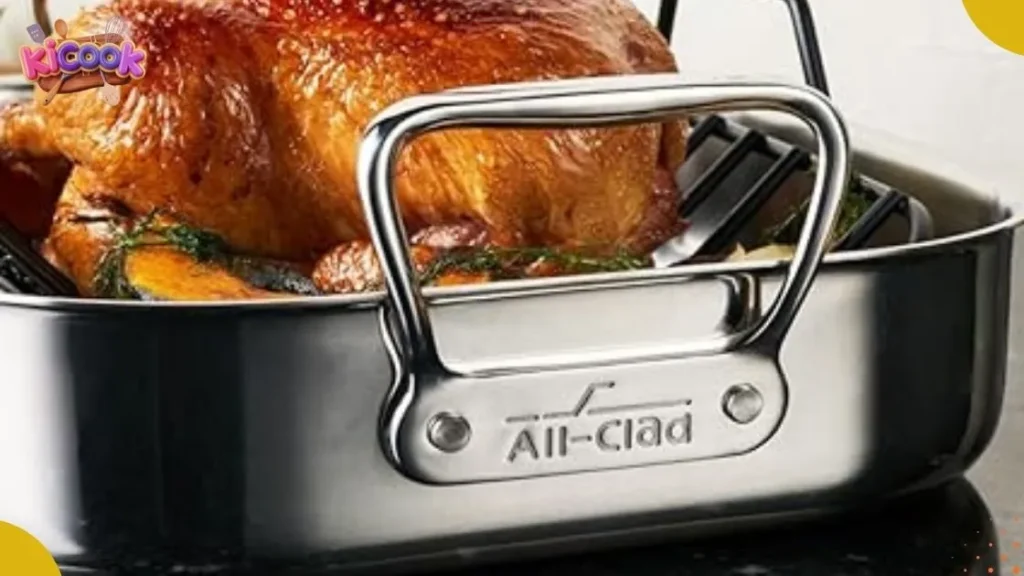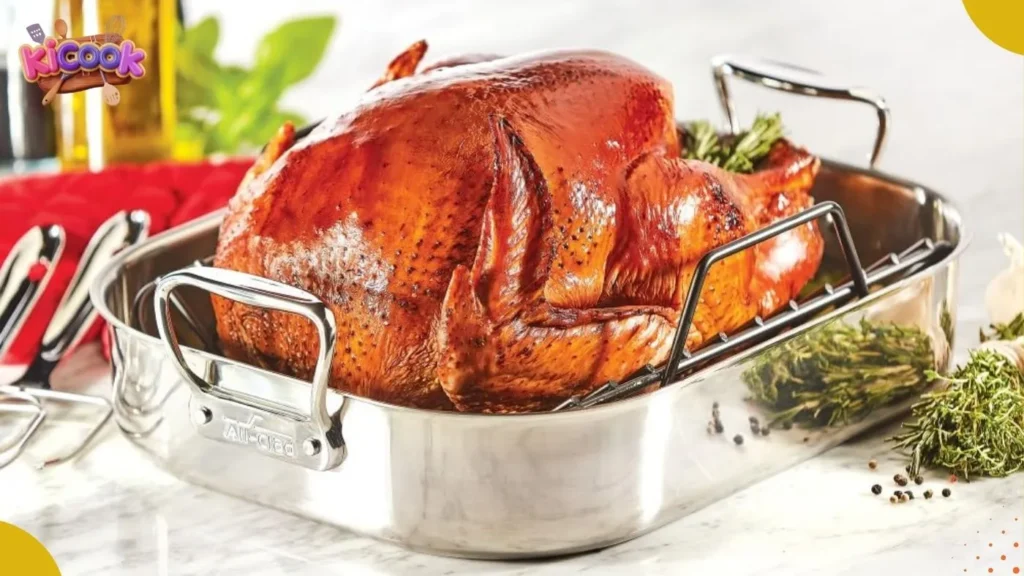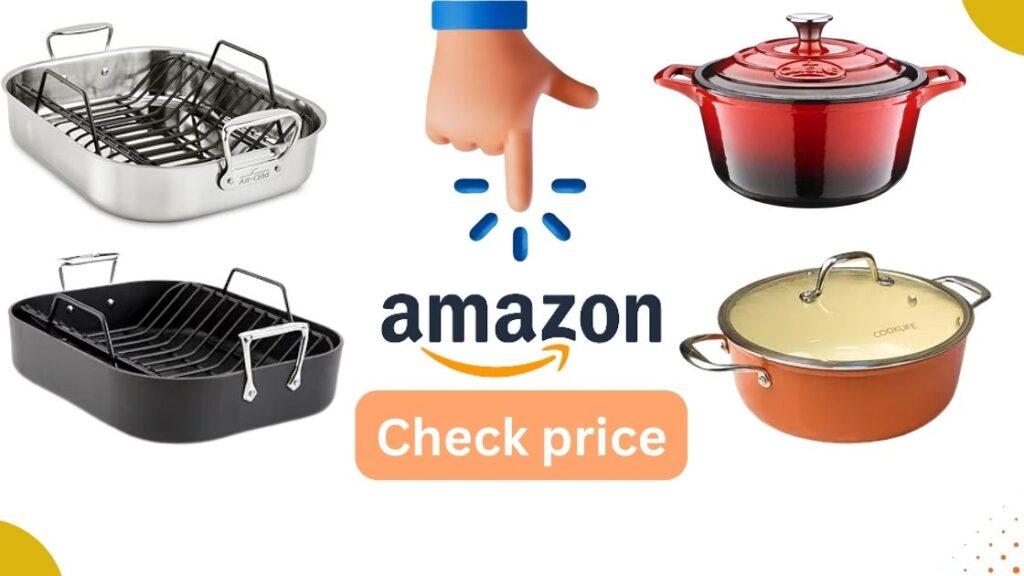When it comes to equipping your kitchen, the choices can be overwhelming. Among the myriad of pots, pans, and skillets, two heavyweights often stand out: the roasting pan vs Dutch oven. Both are revered in culinary circles, but they serve distinct purposes and offer unique benefits. As someone who has spent countless hours in the kitchen, I’ve come to appreciate the strengths and limitations of each.
In this article, I’ll share my insights, personal experiences, and even a few quotes from culinary experts to help you decide which one might be the better fit for your cooking style and needs.
The Roasting Pan: A Versatile Workhorse

What I Love About Roasting Pans?
Roasting pans are the unsung heroes of many kitchens. They are the go-to tools for creating succulent roasts, perfectly browned vegetables, and even baked goods.
Here’s why I think they deserve a place in your kitchen:
- Built to Last: Most roasting pans are made from stainless steel or aluminum, materials known for their durability and even heat distribution. This ensures that your food cooks evenly, whether you’re roasting a turkey or baking a casserole.
- Multi-Purpose: The versatility of a roasting pan is unmatched. You can use it for roasting, baking, and even serving food directly from the pan. This makes it a convenient choice for those who like to streamline their cooking process.
- Easy Clean-Up: Many roasting pans come with non-stick or polished finishes, which make cleaning a breeze. This is a significant advantage, especially after a large meal when the last thing you want to do is spend hours scrubbing pots and pans.
- Size Options: Whether you’re cooking for two or hosting a large gathering, there’s a roasting pan to suit your needs. From compact models to large, family-sized pans, the options are plentiful.
- Handy Extras: Some roasting pans come with additional features like racks or lids, which can be incredibly useful. A rack, for instance, allows for better air circulation and even cooking, while a lid can help retain moisture.
“The only time to eat diet food is while you’re waiting for the steak to cook.” – Julia Child
What Could Be Better
Despite their many advantages, roasting pans are not without their drawbacks:
- Heavy Pans: High-quality roasting pans can be quite heavy, especially when filled with food. This can make them difficult to handle, particularly for those with limited strength or mobility.
- Cost: While there are affordable options available, the best roasting pans can be quite expensive. However, they are a long-term investment and can last for many years if cared for properly.
- Handles: Not all handles are created equal. Some can get hot during cooking, making them difficult to grip. It’s important to choose a pan with heat-resistant handles or use oven mitts.
- Non-Stick Wear: Over time, the non-stick coating on some roasting pans can wear down, leading to sticking and making cleaning more challenging.
My Personal Roasting Story

I remember the first time I used my stainless steel roasting pan. It was Thanksgiving, and I was determined to make the perfect turkey. The pan’s even heat distribution ensured that the turkey cooked evenly, resulting in a golden, juicy bird that had my family raving. That experience solidified my love for roasting pans.
For everyday cooking, I often use a smaller non-stick roasting pan. It’s lightweight and easy to clean, though the non-stick coating has started to show signs of wear after two years. Despite this, it remains a reliable tool for quick meals like roasted vegetables or chicken thighs.
One of my favorite memories is roasting a chicken with potatoes and herbs. The aroma filled the kitchen, and the chicken turned out so tender that even the pickiest eaters asked for seconds.
Is a Roasting Pan Right for You?
Best For:
- Cooks who frequently roast or entertain.
- Anyone looking for a versatile kitchen tool.
Maybe Not For:
- Those who don’t roast often.
- Those who prefer lightweight, simple cookware.
Tips for Roasting Pan Success
- Preheat It: A hot pan helps achieve better browning.
- Use a Rack: Lifting food off the bottom of the pan ensures even cooking.
- Make Sauce: Don’t waste the drippings; use them to make a rich gravy.
- Handle with Care: Avoid using metal utensils on non-stick pans to prevent scratching.
- The Dutch Oven: A Culinary Powerhouse
“Cooking is an art, but all art requires knowing something about the techniques and materials.” – Nathan Myhrvold
What I Love About Dutch Ovens?

👉👉👉Get the Latest Prices and Offers on Amazon👈👈👈
Dutch ovens are the superheroes of the kitchen. Their versatility is unmatched, making them a favorite among chefs and home cooks alike. Here’s why I think every kitchen should have one:
- Super Versatile: From baking and braising to frying and roasting, Dutch ovens can do it all. They effortlessly transition from stovetop to oven, making them incredibly adaptable.
- Made to Last: Constructed from cast iron, Dutch ovens are built to withstand the test of time. With proper care, they can last for decades.
- Stylish Looks: Modern Dutch ovens often come in a variety of enamel colors, adding a touch of elegance to your kitchen and table.
- Many Sizes: Whether you’re cooking for a small family or a large group, there’s a Dutch oven size that fits your needs.
- Easy to Clean: The enamel coating on many Dutch ovens makes cleaning much simpler. No more endless scrubbing.
What Could Be Better
However, Dutch ovens are not without their challenges:
- They’re Heavy: A full Dutch oven can be quite heavy, making it difficult to lift, especially for those with weaker arms or wrists.
- They’re Pricey: Premium brands like Le Creuset and Staub can be expensive. While there are more affordable options available, they may not offer the same level of quality.
- Fragile Coating: The enamel coating can chip if the pot is dropped. This can be a significant drawback for those who are clumsy or have children.
- Some Need Extra Care: Uncoated models require seasoning and can rust if not properly cared for.
My Dutch Oven Experience

👉👉👉Get the Latest Prices and Offers on Amazon👈👈👈
When I first purchased my Lodge 5-quart Dutch oven, I wasn’t sure how much I’d use it. I started with simple stews, which turned out delicious. Then I ventured into bread baking. The results were nothing short of magical—the crust was perfectly golden and crispy.
But it’s not all smooth sailing. Carrying a heavy pot full of soup feels like a workout. I later tried a Le Creuset Dutch oven, and while it was beautiful and easy to clean, it was also significantly more expensive than my Lodge. Still, serving food directly from it felt luxurious.
“A Dutch oven is the original multi-cooker.” – Alton Brown
Should You Get One?
Yes, if you:
- Love slow-cooking, bread baking, or one-pot meals.
- Want a tool that can handle almost anything.
Maybe skip it if you:
- Don’t need heavy-duty cookware.
- Prefer something lighter and easier to handle.
Tips for Dutch Oven Success
- Choose the Right Size: A 5-7 quart pot is ideal for most kitchens.
- Opt for Enamel: It’s easier to use and clean.
- Protect the Finish: Use silicone or wooden utensils to prevent scratching.
- Let It Cool: Avoid cracking the enamel by cleaning the pot only when it’s cool.

👉👉👉Get the Latest Prices and Offers on Amazon👈👈👈
Roasting Pan vs Dutch Oven: The Showdown
Cooking Capacity
Both the roasting pan and the Dutch oven can hold a lot of food, but they have different strengths. Roasting pans are excellent for large cuts of meat like turkey, while Dutch ovens are better suited for soups, stews, and smaller dishes.
Material and Durability
The material of each cookware piece significantly impacts its performance. Roasting pans are typically made of stainless steel or aluminum, which are durable but can dent. Dutch ovens, on the other hand, are made of cast iron, which is extremely durable and retains heat well.
Heat Distribution
Heat distribution is crucial for even cooking. Roasting pans are good for high-heat roasting and browning, while Dutch ovens excel at retaining and evenly distributing heat, making them ideal for slow cooking.
Ease of Use
Ease of use is another factor to consider. Roasting pans are generally lighter and easier to handle, while Dutch ovens are heavier but offer more cooking options.
Value for Money
The cost and lifespan of each also vary. Roasting pans are more affordable upfront, while Dutch ovens are a more significant investment but last longer.
Final Verdict
Both tools are valuable, but they serve different purposes. If you frequently cook large roasts or entertain, a roasting pan is a great choice. However, if you’re looking for a versatile tool for everyday cooking, a Dutch oven is the way to go.
My Recommendation
If you’re someone who loves to cook big meats, a roasting pan is your best bet. It’s perfect for holiday meals and large gatherings. But if you want a tool that can handle soups, stews, and bread baking, a Dutch oven is the superior choice.
I personally use my Dutch oven more often than my roasting pan. It’s ideal for sourdough bread and hearty soups. The roasting pan is reserved for special occasions, but my Dutch oven handles most meals with ease.
FAQs: Roasting Pan vs Dutch Oven
Can a Dutch oven replace a roasting pan?
A Dutch oven can work for smaller dishes, but it doesn’t have the large surface area of a roasting pan. It’s not ideal for big cuts of meat or poultry.
Which is better for everyday use: roasting pan or Dutch oven?
A Dutch oven is more versatile for daily tasks like soups, stews, and baking. A roasting pan is better for larger roasts or special meals.
Are Dutch ovens more durable than roasting pans?
Yes, Dutch ovens last longer. They’re made of cast iron or enameled cast iron, while roasting pans are usually aluminum or stainless steel and can warp.
What’s the cost difference between a roasting pan and a Dutch oven?
Roasting pans cost less, usually between $30 and $70. Dutch ovens range from $50 to over $300, depending on the brand.
In conclusion, the choice between a roasting pan and a Dutch oven depends on your cooking habits and preferences. Both have their merits, and both can be valuable additions to your kitchen. Consider what you cook most often and how you like to cook, and you’ll be well on your way to making the right decision.

